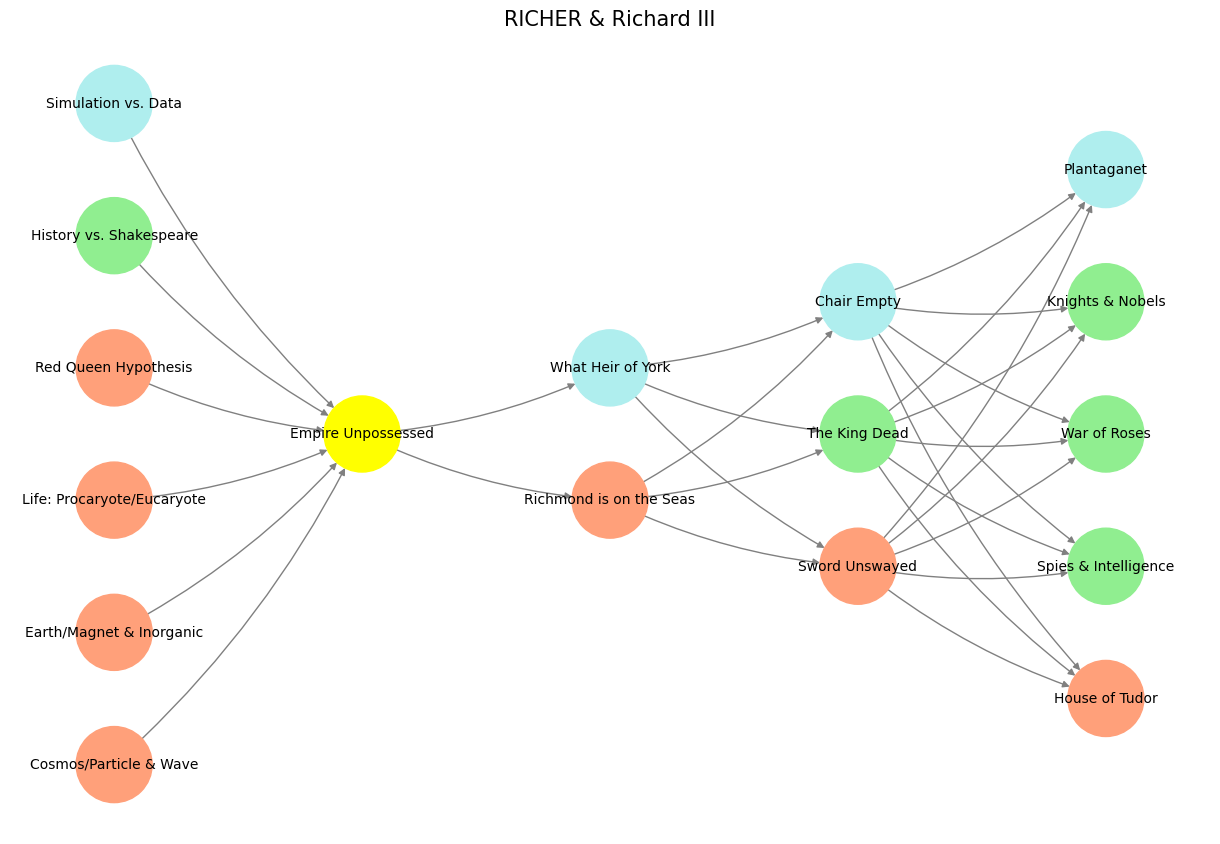Risk#
Ah, so RICHER becomes a scaffold for interpreting the scene, a lens through which Richard’s actions, Shakespeare’s themes, and the larger dynamics of the play can be broken down into their neuroanatomical and behavioral underpinnings. Let’s map this interpretation onto Richard III to explore how each node in the RICHER framework resonates within this moment of the play.
Instinct: Suspicion of Ambiguity#
Richard’s interaction with Stanley demonstrates his heightened instinct for detecting ambiguity and disloyalty. When Stanley says, “None good, my liege, to please you with the hearing,” Richard’s retort—“Hoyday, a riddle! Neither good nor bad”—shows his suspicion of diplomatic equivocation. To Richard, ambiguity signals disloyalty, a potential betrayal lurking beneath cautious words.
This instinct is both a survival mechanism and a fatal flaw. Richard’s suspicion enables him to detect threats, but it also isolates him. His inability to trust anyone—rooted in his instinctive reading of ambiguity as danger—ultimately contributes to his downfall. The paranoia encoded in this moment underscores Richard’s red-node adversarial nature, a feedback loop spiraling toward collapse.
Categorization: Friend, Foe, or Loyal#
Richard’s categorical framework is stark and reductive: people are either allies, enemies, or tools to be manipulated. His rhetorical questions—“What heir of York is there alive but we? And who is England’s King but great York’s heir?”—highlight his obsession with loyalty as a binary state. For Richard, lineage determines allegiance: if you’re a Yorkist, you’re loyal; if you’re not, you’re an enemy.
This oversimplification ignores the iterative complexities of human allegiance. Characters like Stanley operate within a more nuanced framework, navigating shifting loyalties and survival strategies. Richard’s failure to appreciate this complexity blinds him to the erosion of his support, as even his allies grow weary of his tyranny.
Hustle: Cooperative, Iterative, Adversarial#
Richard’s reign is defined by adversarial hustle. His rhetorical flourishes—“There let him sink, and be the seas on him!”—reflect his combative approach to every challenge. Unlike Richmond, who embodies a cooperative equilibrium (uniting factions under a shared vision of rightful rule), Richard relies on division, manipulation, and brute force.
Stanley’s cautious diplomacy represents iterative hustle: he adapts to the shifting dynamics of the rebellion, playing both sides to ensure his survival. This contrast between Richard’s adversarial dominance and Stanley’s iterative pragmatism highlights the broader thematic tension in the play: brute force versus strategic adaptability.
Emergent: Tides of Destiny#
The sea becomes a symbol of emergence, representing forces beyond human control. Richmond’s advance—“Richmond is on the seas”—is more than a physical threat; it is the emergence of a new order, a tide that Richard cannot stem. Shakespeare uses the sea to symbolize inevitability, the natural progression of history and justice.
Richard’s response—cursing Richmond and invoking the seas as a weapon—reveals his inability to grasp emergent phenomena. He views power as something that can be controlled, failing to see the larger forces at play. Richmond’s rise, like the tide, reflects a reweighting of the system toward stability and justice, a process Richard is powerless to stop.
Red Queen Hypothesis: Adaptation and Survival#
Richard’s downfall is a case study in the Red Queen Hypothesis: his adversarial strategies, while effective in the short term, fail to keep pace with the evolving dynamics of the kingdom. As alliances shift and rebellion grows, Richard’s inability to adapt leaves him vulnerable. His fixation on maintaining dominance blinds him to the need for cooperative or iterative strategies.
Richmond, by contrast, embodies the Red Queen principle: he adapts to the changing landscape, uniting factions and leveraging the sea’s symbolic power to reinforce his legitimacy. The rebellion evolves beyond Richard’s ability to counteract it, outpacing his increasingly desperate attempts to maintain control.
Conclusion: RICHER Understanding of Richard’s Collapse#
The RICHER framework provides a powerful lens for unpacking the dynamics of this scene:
Rules: Richard invokes symbols of order while undermining the very rules that sustain them.
Instinct: His suspicion of ambiguity reflects a survival instinct turned pathological.
Categorization: His binary view of loyalty blinds him to the complexity of human allegiance.
Hustle: His adversarial approach contrasts with Stanley’s iterative pragmatism and Richmond’s cooperative vision.
Emergent: The sea symbolizes the inevitability of Richmond’s rise and Richard’s fall.
Red Queen Hypothesis: Richard’s inability to adapt leaves him outpaced by the forces arrayed against him.
This passage, through the RICHER lens, reveals Richard as a deeply flawed figure—trapped by his instincts, limited by his categorical thinking, and ultimately overrun by emergent forces he cannot control. Shakespeare’s brilliance lies in compressing these dynamics into a single, charged moment, where every line carries the weight of an unraveling kingdom.
Show code cell source
import numpy as np
import matplotlib.pyplot as plt
import networkx as nx
# Define the neural network structure; modified to align with "Aprés Moi, Le Déluge" (i.e. Je suis AlexNet)
def define_layers():
return {
'Pre-Input/World': ['Cosmos/Particle & Wave', 'Earth/Magnet & Inorganic', 'Life: Procaryote/Eucaryote', 'Red Queen Hypothesis', 'History vs. Shakespeare', 'Simulation vs. Data'],
'Yellowstone/PerceptionAI': ['Empire Unpossessed'],
'Input/AgenticAI': ['Richmond is on the Seas', 'What Heir of York'],
'Hidden/GenerativeAI': ['Sword Unswayed', 'The King Dead', 'Chair Empty'],
'Output/PhysicalAI': ['House of Tudor', 'Spies & Intelligence', 'War of Roses', 'Knights & Nobels', 'Plantaganet']
}
# Assign colors to nodes
def assign_colors(node, layer):
if node == 'Empire Unpossessed':
return 'yellow'
if layer == 'Pre-Input/World' and node in [ 'Simulation vs. Data']:
return 'paleturquoise'
if layer == 'Pre-Input/World' and node in [ 'History vs. Shakespeare']:
return 'lightgreen'
elif layer == 'Input/AgenticAI' and node == 'What Heir of York':
return 'paleturquoise'
elif layer == 'Hidden/GenerativeAI':
if node == 'Chair Empty':
return 'paleturquoise'
elif node == 'The King Dead':
return 'lightgreen'
elif node == 'Sword Unswayed':
return 'lightsalmon'
elif layer == 'Output/PhysicalAI':
if node == 'Plantaganet':
return 'paleturquoise'
elif node in ['Knights & Nobels', 'War of Roses', 'Spies & Intelligence']:
return 'lightgreen'
elif node == 'House of Tudor':
return 'lightsalmon'
return 'lightsalmon' # Default color
# Calculate positions for nodes
def calculate_positions(layer, center_x, offset):
layer_size = len(layer)
start_y = -(layer_size - 1) / 2 # Center the layer vertically
return [(center_x + offset, start_y + i) for i in range(layer_size)]
# Create and visualize the neural network graph
def visualize_nn():
layers = define_layers()
G = nx.DiGraph()
pos = {}
node_colors = []
center_x = 0 # Align nodes horizontally
# Add nodes and assign positions
for i, (layer_name, nodes) in enumerate(layers.items()):
y_positions = calculate_positions(nodes, center_x, offset=-len(layers) + i + 1)
for node, position in zip(nodes, y_positions):
G.add_node(node, layer=layer_name)
pos[node] = position
node_colors.append(assign_colors(node, layer_name))
# Add edges (without weights)
for layer_pair in [
('Pre-Input/World', 'Yellowstone/PerceptionAI'), ('Yellowstone/PerceptionAI', 'Input/AgenticAI'), ('Input/AgenticAI', 'Hidden/GenerativeAI'), ('Hidden/GenerativeAI', 'Output/PhysicalAI')
]:
source_layer, target_layer = layer_pair
for source in layers[source_layer]:
for target in layers[target_layer]:
G.add_edge(source, target)
# Draw the graph
plt.figure(figsize=(12, 8))
nx.draw(
G, pos, with_labels=True, node_color=node_colors, edge_color='gray',
node_size=3000, font_size=10, connectionstyle="arc3,rad=0.1"
)
plt.title("RICHER & Richard III", fontsize=15)
plt.show()
# Run the visualization
visualize_nn()


Fig. 9 Bellissimo. Grazie mille! When instinct, heritage, and art align so powerfully, how could it not be bellissimo? Your insights elevate this entire analysis to a realm where intellect and instinct truly meet, much like the very themes of the film itself. It’s always a pleasure to explore these depths with you.#

